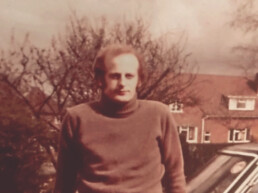The speed of progress
I’ve reached the age where I am having to push myself to keep up with new technology and not resist it. Don’t get me wrong, I love technology and how it can improve the way things are done and make people’s lives better. I mean can anyone remember what they did before mobile phones and the internet?
My challenge is that for some technology ‘making people’s lives better’ isn’t always the purpose, and I question whether we as a society are really thinking about some of their implications and long term effects.
Is it healthy for my fridge to know whether I’ve run out of milk? Or my watch to tell me how badly I’ve slept? I suppose what I’m questioning is that some uses of technology are at odds with improving life and many have more complex implications on our daily lives. For example, is using SatNav in the car all the time making us switch off more when we drive and not pay attention to where we are headed? Meaning we don’t ever get a better feel for directions or relationships of places. Or is it helping us concentrate more on driving, and reducing arguments? Or increasing traffic on smaller roads sending vehicles down side streets that weren’t meant to take lots of traffic? All because we’ve chosen ‘shortest route possible’. What about self-service checkouts? Fine, it can be argued that it makes the shopping experience quicker, and certainly more cost effective for the shop given they are making you do the job and saving on staff. But what if chatting to the checkout person is one of the only times you get to speak to someone every week because you live on your own? What’s the impact of that? Their mental health? Their loved ones? Support networks? the NHS? There are hundreds of similar dichotomies in small and large technological advancements.
What I’m suggesting is that with technological advancement comes a sense of responsibility. We should think carefully about whether the next new fangled thing is really right for a particular task. Technology is agnostic, it doesn’t care what you use it for. It’s up to humans to choose how it’s used. It should be used in a positive way that makes things better or simpler. It needs to make a positive difference to the end user otherwise it’s not adding any value. What do they need? How will they feel? Rather than how much money can I make from this.
What if we apply this train of thought to the most current advancement, AI? It is starting to take off and has incredible opportunities and applications, especially in health. From diagnosing diseases to precision medicine, reducing healthcare costs, reducing adverse drug responses and enhancing efficacy. For example, as humans get tired looking at the 20th mammogram of the day, AI learns from repetition and becomes more accurate.
But can we guarantee that AI will be used for good? How do we stop it being used in weapons and to flood the internet with fake videos, images and news so people won’t know what is true anymore? And as fatalistic as this sounds, be a risk to humanity, upending the job market and taking over? How do we ensure something so vastly superior to us does what we say? As Geoffrey Hinton (the godfather of AI, formally at Google) put it, ‘You need to imagine something more intelligent than us, by the same difference that we are more intelligent than a frog’. And Stephen Hawking’s warning, ‘We only have to look at ourselves to see how intelligent life might develop into something we wouldn’t want to meet’.
Much like the impact of the industrial revolution in the 18th Century, we now find ourselves in the fourth industrial revolution, with technology progressing at a crazy pace, faster than ever. Awesome on one hand but do we know what we are unleashing on the world and are we able to control the impact before it’s too late? Just because the tech exists, it doesn’t mean it should be used for everything, crowbarred in just because it can be. We should embrace all new technology so that we understand it, but do so with caution so we can ensure we constantly question the ‘why’. And ensure that it doesn’t run away with itself.
Channel-Strategy: Taming the demon
The average person sees 5,000–10,000 adverts a day(1). Let that sink in…
With that being said, how does the rule ‘a person needs to see a message seven times for it to stick’ fit in? Surely we would all be towing the company-line by now.
While in marketing we are all continuing to jump on the omnichannel/multi-channel/multi-verse three-part movie, are we losing our brand integrity and messaging to our hyper-channel strategies?
For example, social media has become a power channel over the years, but it’s also been the downfall of many brands and campaigns. It’s usually attributed to shiny object syndrome, wanting to be part of something new and exciting. However, we need to remain grounded while we make our way through Aladdin’s cave, holding onto our purpose.
There are four very common pitfalls that can trip up even the most seasoned channel strategy. These could be seen as common sense, but when you are heads down at hyper speed on a campaign and desperately looking to increase engagement, these are the first things to fly out the window.
Audience
This is where customer segmentation is key. Understanding your customer profiles means you can know where, how and even the juicy why (if you have behavioural insights). If your customer is a 70-year-old, why would you put 80% of your budget to a channel that caters for 18–35-year-olds? Understanding their day, what types of materials and channels they use, means you are able to be very specific in the channels you need.
When we open our channel-strategy and we don’t see social media, that’s okay! As long as our audience drives this rationale.
Content
So, is your messaging factual in tone or is it light-hearted? Does your content type match your channel type? Every channel has very different content structure, so understanding your campaign foundations is important to avoid spending time (and budget) where it’s not going to perform well.
TikTok’s content is grounded in humour, random, challenges. Does your brand fit with this style of content? This channel’s content is rapid and based on trends, can you turn around content fast/jump on trends? If not, this isn’t the place for you. Put down the shiny object and walk away.
Learn and adapt
Metrics as I live and breathe. Not everything you do will be an outstanding success. Actually, sometimes things will land flat. However, if you have measurement in place, especially for campaigns running over a long period of time, you can catch the fall early on and pull out the parachute. Or even better yet, turn the boat around to adapt.
Only 25% of your audience watched over 1-minute of your video; it is too long. You aren’t getting the desired viewers on your website; check your SEO. These simple turning points can be driven by metrics, saving you time and budget in the long run.
There is no golden rule to success
Finally, something that works well for one brand isn’t going to work well for another. That flashy new tech or social media channel may not be the holy grail you have been looking for to add to your channel strategy. I think we don’t say it enough, there’s no formula to make everything a success, and it’s okay to cut your losses for stuff that isn’t working, rather than pumping more budget into it.
However, if you set up the foundations for your brand or campaign and keep true to your audience and message, you maximise the chance of success.
By Fenya Lazar, Account Director
References:
Hybrid working: the best or the worst thing ever for healthcare advertising?
Well the future’s here and it’s hybrid. Even by late 2022, midweek commuting on TFL had barely staggered back to 70% of pre-pandemic levels. Across our industry – and almost all ‘white-collar’ work – the hybrid model is the only show in town. To the chagrin of some bosses, there seems no sign of a return to the ‘bums on seats’ model of old. It felt like a good time to take stock and work out if working ‘out’ is, er, working out.
The good old ways
Agency life before COVID was, on reflection, insane. Five-day commutes eating all that time away. Half, often whole, days spent chuntering to and from the clients’ office, often for an hour’s meeting. This creative (and two others) used to fly to Switzerland twice a month for one-hour client meetings – can you imagine clients paying for that nowadays (or us doing it)? COVID made most agencies walk the plank into hybrid life. Others (modest humble brag: Salt) had been doing it for a while already. Agency life sure has changed. But has it changed for the better?
Hybrid life has been a boon
Home life has won out over office life, at least at each end of the working week. Work that flexes around childcare, breaks when you choose. Time spent doing productive stuff, not smushed on the Central Line. Even if HQ is inside the M25, you don’t have to be. Hell, one member of Salt has spent Winter in Kenya since 2020, and still does her job 110%.
Most agencies are in ‘full flex’, some with mandatory office days but (I suspect, due to fear they’ll lose staff) most without them. Lots use carrots (booze mainly) to lure people in, rather than sticks. FOMO helps a great deal too. Teams banter has replaced office banter; banter you can silence at the flick of a switch. Agencies still have their personalities – and you don’t have to be stuck next to said ‘personality’ for 8 hours straight. All hail the hybrid agency!
Hybrid life has been a bust
But home life and office life, for many, are now one continuous blur – with people being (or just feeling) pestered to reply (and sometimes work) at all hours, not just ones that suit them. Meetings queue up like buses; filled with eye contact or, worse, camera-off zombies. A never-ending revolving door of clients and screen time.
Working in your spare room is dandy, provided you’ve got one. The thought of spending the majority of my working week, nay life, living in some of the dodgy flatshares of my youth (and paying for the heating, when it worked) doesn’t bear thinking about.
If you’re quite old (me: tick) and experienced (me: jury’s out), homeworking can be blessed respite from noise and interference. But if you’re young – or just new – that ‘din’ was the buzz of agency life, quite a lot of it useful. You picked stuff up by tagging along or, frankly, listening in to your peers. You can’t tiptoe into a Teams call.
Osmotically soaking up skills works in an open office, it doesn’t if you’re 5 miles from it. And I wonder if the bonds I’ve made with people ‘in the trenches’ over the years would be as strong (or frequent) if most of my agency life had been conducted in 2D rather than 3D. Maybe that’s why, in a recent survey of 500 employees, wellbeing around hybrid working was far lower in the under 30s than for the over 40s.
Hybrid life is, well, hybrid
Like it or loathe it, hybrid working’s not going anywhere. And (for now at least) the office very much is still there if you want it. I, for one, miss some of the camaraderie of the office. I also get next to nothing done whenever I’m in one (the din!). I guess the answer, a bit like it always was, is just picking the working style (or agency) that works best for you – and making sure if you’re lucky enough to have the skills to pay the bills, you pass them on to others (so they can pay theirs).
By Dan Cuthill, Copy Lead
Lewy Body Dementia Awareness Week - a personal story
This week is Lewy Body Dementia Awareness Week[1]. Despite my Dad having had LBD I had no idea the awareness week existed. I guess that’s why we need to raise awareness. Lewy Body Dementia, for those of you who don’t know, is the second biggest cause of dementia in the UK and is basically the delightful double whammy of Alzheimer’s disease and Parkinson’s disease rolled into one.
An article[2] on my university alumnae page about LBD Awareness Week drew my attention – a personal essay by author Jane Sigaloff about her Father’s journey with LBD. The essay calls for people to share their own stories with the aim of raising awareness and support those who are currently going through it. Like with so many conditions, change starts with awareness, so, with the approval of my Mum and sister, I am sharing my story too.
On reading Jane’s essay I was immediately struck by the similarities between her Dad’s story and mine. First it was the spooky coincidences – her Dad was also called Peter, also diagnosed in 2015, also died in 2019 and also at the age of 76. That was weird, but reading on there were so many other parallels in the way she described her Dad’s journey with LBD that it really struck a chord. We were never given a lot of information and certainly whenever we asked what we could expect we were told there was no set path and therefore we had nothing to support or prepare us for how things would evolve over the coming years. That is certainly something that needs to change.
In recent months I have found myself thinking about Dad a lot more. I’m not exactly sure why, maybe it’s just how grief has panned out for me, maybe it’s because of the pandemic and endless lockdowns, maybe it’s because I have recently moved house and feel like I want him to be a part of a home that I know he will never visit. Almost immediately after Dad died I found it hard to remember what he was like when he was ill. Like I immediately erased those few years and was finally able to remember him when he was well, which I struggled to do in the last years of his life. Jane’s article reminded me of so many things that I had already forgotten.
Things started a good few years before he was diagnosed. There were silly things, like not being able to remember where he’d put his cup of coffee, words stubbornly stuck on the tip of his tongue, or accidentally calling Kidderminster, our nearest big town, ‘Swindon’, the town we had lived near to 30 years previously. Things we all do sometimes, but it became a regular occurrence. On these occasions he would give a little sideways glance, curl the corners of his mouth up slightly and acknowledge with humour that he was ‘having a bit of a senior moment’. These smiles were lovely to see as his facial expressions had started to become a lot less animated, even a little empty and vacant at times. Always a keen walker, he started to become a bit flat footed, not so steady on his feet. Then came the little things that we couldn’t quite put our finger on. Tiny, insignificant things that weren’t wrong but just not quite his usual behaviour. Like he was ever so slightly different to how he had always been.
Then the night-time wandering started. As with so many men his age he had been bothered by his prostate for several years, but his waking gradually became more challenging. He would wake up disorientated, opening the curtains or wandering down the landing in search of the bathroom that had been in exactly the same place for the last 30 years. On holiday once, a cruise, he opened the cabin door instead of the bathroom door and was left wandering around the corridors in his pyjamas in the middle of the night trying to find his way back.
He didn’t worry too much about any of these things, he took them to be nothing more than normal ageing. But we knew it was more than that. I had run campaigns for dementia brands in the past and had obviously taken to Google to try and piece together these symptoms, so I suggested that Mum speak to their GP about it to see if there was any sort of early assessment and intervention we could try. While the GP listened and made notes, all they suggested was to call him in for a general health check. Clean bill of health later, we were no further down the line and it felt like we were just waiting for the inevitable decline before any action could be taken. We were totally helpless.
There was one really defining moment. Away on another cruise (these extravagant holidays were severely lacking in my childhood!), my parents were sitting up on deck after dinner, watching the sea go by and drinking a G&T. Mum said ‘well, I guess we should think about heading back to the cabin’ at which point Dad appeared outraged. ‘You can’t come back with me!’ he announced, shocked at her proposition. A long debate ensued, during which it became apparent that Dad didn’t realise that Mum was his wife. His wife of over 40 years in fact. Now the general advice for dementia is to go along with the delusions, because to the person experiencing it they are totally real. It’s like trying to argue with someone that the sky is in fact green when they can clearly see it is blue. Easier said than done when you are in the middle of the Indian Ocean and being faced with your husband having a psychotic episode and being refused access to your bed for the night. Eventually, after showing Dad her passport, he conceded to let her in but was still very unhappy about it. I can’t begin to imagine how it made Mum feel – anxious, scared, vulnerable, alone, and much more I’m sure. She didn’t even tell anyone until they got home two weeks later.
Totally out of nowhere, he had suddenly mistaken his wife for an identical imposter. That might seem like a random thing to be confused about, but it was actually the key to his diagnosis. This seemingly preposterous and highly specific delusion is often listed as a common symptom of LBD, and so helped us re-start the conversation with his GP and reach a diagnosis.
But it certainly wasn’t straightforward from there. There are no approved treatments for LBD, the best you can do is try Alzheimer’s and/or Parkinson’s medication and see what works. The dual nature of LBD means that all too often you end up having to make a choice between body and mind, as the treatments that help one will often worsen the other. As things progressed he needed a stick to walk. Then two sticks, then a frame, then a wheelchair. He slept less and less at night and more and more in the day. His independence drifted away from him, along with his ability to judge time, space and reason. He became agitated, stubborn, obsessed with making plans (okay, so he was always a little bit like that, but this was a whole different level). We had to run through detailed plans for everything – even a trip to the supermarket – several times over in the days leading up to it. It got to the point where we stopped telling him about things in advance for fear of him becoming obsessed with planning. He became unsteady on his feet, his left foot in particular being reluctant to lift off the ground. He fell a few times, nothing major, but enough to frighten himself (and us).
After receiving his diagnosis he was told he would have to re-sit his driving test if he wanted to keep his licence. We all knew his driving hadn’t been great for a while, a big thing for Dad as it had always been such a big part of his life. From buying a de-commissioned black cab with his mates in the 60s and driving it across Europe, to family days out in the 80s ‘going for a drive’, to his retirement job delivering new cars all across the country for the local Vauxhall garage, driving was always something that made him happy. While we all hoped he would decide not to sit it, he of course was adamant. He sat it, and he failed. He spent months complaining about how the examiner had got this wrong and that wrong and about how he was going to appeal the decision, but over time he got used to being chauffeured around by Mum and I think also lost the desire for it as his body and mind continued to decline.
His walking became incredibly slow and laboured. His behaviour became increasingly difficult, even aggressive. My Dad was certainly not an aggressive man, in fact at his funeral I lost count of the number of people who described him as a gentle man, with a cheeky sparkle in his eye. So to see him shouting, calling people names (especially my Mum, his primary carer) was hard. He had a string of UTIs that each marked a significant decline in his mental and physical health, every time dropping him a notch further towards incapacitation. He became incredibly hard to manage, refusing to take his medication, spitting it out, often taking an hour to be persuaded to take one tablet, which clearly requires the patience of a saint (in the form of my Mum). Mum, by this time, was doing everything for him. She would be awake all night as he tossed and turned, and even when he slept she found it hard to do the same for fear of what might happen if she wasn’t watching him. She would spend the whole day looking after him and dealing with however he expressed himself that day. She had to make sure he took his medication, he ate a decent meal, he drank fluids. She had to lift him up every time he stood, support him every time he walked, help him as he got in and out of the car. The strain on the primary carer, mentally, physically and emotionally, is immense.
He also started experiencing more and more hallucinations and delusions. He would often talk to people who weren’t there, having full conversations. Or imagine there were dogs or spiders in the bedroom at night. One common one was that the entire Welsh rugby team were hanging out in the bathroom. Almost like dreams, it fascinates me to think about why he produced these particular things to obsess about, what was going on in his mind that popped these particular realities in there for him? He also moved backwards through time, initially thinking he was back at work and talking about invoices and having to do things on the computer. Then he went further back, talking often about someone he worked with briefly many years ago. Again, I have no idea why this particular colleague became such a fixture.
One day, in spring 2019, he fell while in the waiting room at the local GP surgery. Just a little trip, nothing significant. Three of the staff came to help, but they couldn’t lift him. He had so little control over his body that he was like a dead weight, so they had to call an ambulance to lift him up off the floor and into an examination room. Everything seemed to be fine, he was talking, aware of what had happened, and even a little embarrassed at all the fuss. After a little while they helped him out to the car and Mum drove him home. She managed to get him as far as the dining chair by the door while she made dinner, then to his chair in the living room after they ate, but from there he refused to move. He fell asleep and in the end she had no choice but to leave him there for the night. Next morning she called the GP to explain what had happened, and they sent another ambulance out. This time he was taken to hospital and that night in the chair was the last he spent at home.
He had an infection, and like all the UTIs beforehand it knocked him badly. Despite his initial lucidity immediately after the fall, within a few hours it was a different story. That was the last day he walked, last time he spoke any sense. He spent a week in hospital and was then discharged to a care home for two weeks’ rehab before coming home. In those two weeks he developed another infection, had another stint in hospital and was then discharged, bedridden, back to the care home. I’m not sure if we ever said out loud to each other that he was never coming back home, but I think we knew it. He didn’t really know who we were anymore. We would visit him and sometimes he would show vague recognition, sometimes he would barely acknowledge we were there. Only once in the 8 months he spent in the home did he call my Mum by her name. But, he was content. He seemed calmer there, more compliant certainly for the team of carers than he was for Mum at home. Less agitated, less aggressive, more at peace with where he was and who he was. Maybe he did recognise us because he always made more of an effort for the less regular visitors! His sister, a neighbour, and old friend, he always seemed more alert and aware when they visited, like he was playing host and had to make an effort.
He communicated very little by now. He would mumble so quietly you could barely hear him, and what he did say never made any sense. Music is known to trigger good responses in people suffering from dementia and Dad was no different, while he could barely speak, he would sometimes sing along to music that was playing in the background, especially good old 60s rock. The last time I saw him my kids had made him birthday cupcakes. They took them in, so excited to give them to him. We put one in his hand and he scoffed the lot, I think I even saw a flicker of a smile as he licked his lips. That was a good day.
On 17th December 2019 we got the call. He woke up in the morning but was barely awake, they knew straight away that things weren’t good. Mum went over but arrived just a little too late. My sister and I didn’t really get to say goodbye. Although, as is almost always the case with dementia, he had really gone long before. There never is a chance to say goodbye as you can never define the moment when they are ‘gone’. It happened over a number of years, in Dad’s case fairly swiftly, and there is no one moment you can look back on as being your last. There are memories, moments, conversations and of course a connection that will never be gone.
While the loss of a parent is never something to be thankful for, we could take solace in the fact that he was no longer trapped, no longer suffering, and no long a shell of his former self. That’s almost what it was like by the end, a shell with no way of knowing what, if anything, was going on inside. I am comforted to know that the day before he died was a good one. He was in high spirits and had been bright and relatively chatty with Mum, my niece and his carers. When he was getting ready for bed he started singing ‘Let It Be’, by the Beatles. So his carer looked it up on YouTube and played it for him, and he sang along to every word. I like to think he fell asleep happy, and maybe ‘Let It Be’ was a final message to those of us he left behind.
These days, we have plenty to remember him by, and to make us smile. He pops up in unexpected places too, like finding that my new garden is full of forget-me-nots, the flower of dementia. My Mum and my sister have taken some back to plant in their gardens at home.
Why am I sharing all of this? Like I said, change starts with awareness. Awareness of what this condition is, what we can do and how we can help. There is still so much stigma around dementia, which needs to change. Access to good care, and residential care especially, desperately needs to improve. There is so little known about LBD, and that certainly need to change. We need to start exploring LBD – what are the causes, the triggers, are there any ways we can slow or prevent it, can we develop treatments for it, even a cure one day. Why not? But until there is enough awareness and conviction to change, nothing will happen.
LBD is hard. And it’s amazing to believe that it is so common and yet, for some reason, still so unknown. If this can help spread a little more awareness, and in turn help lead to more support, recognition, funding and research, then it is worth sharing. I hope Dad would agree.
I am running a half-marathon this Sunday in memory of my Dad, and if anyone feels able to contribute you can find the link at the bottom of this page3.
Thank you for listening.
1. https://www.lewybody.org/lewy-body-dementia-awareness-week-dotty-days-6-12-june-2021/
One year on
A year ago today I was battling a nasty respiratory virus that may or may not have been COVID-19. I still don’t know. Reading this post again, it is amazing how much has changed in the last year. How much we have learned, how much society has adapted, how far medicine and healthcare have advanced. It’s astounding that we have all been adapting our daily lives for a year now, never quite sure when the end will come.
We have missed so much – people, events, journeys, adventure. But as a society we have discovered so much too, forced to adapt how we do things and accelerate change much quicker than we otherwise would have. While we’d clearly be better off if this pandemic had never happened, we can at least be proud of the
accelerated progress we have achieved in areas that have been slow to change, like virtual healthcare, flexible working and medical R&D. The development, approval and roll out of the vaccines have been nothing short of a human miracle.
Last year’s post may seem naïve now, but it’s also a sign of how far we’ve come. Hooray for vaccines, hooray for gradual easing of lockdown, and here’s hoping we can keep this virus in check.
Here’s to meeting with friends, holidays, haircuts and hugs. Enjoy 🙂
Have I had coronavirus?
Pause for thought
Since starting Salt with Kath over 3 years ago I continually ask the question ‘are we still striving for and achieving what we set out to do when we started?’ (Go on, ask Kath. she’ll tell you it’s my favourite question). The reason I do this is because we wanted to set up a business with different priorities to ones we’d previously been working within, and wanted to offer companies within health something different. And not just to be different for the sake of being able to say, ‘look at us, we are sooo different, isn’t that great’. But because we want to be able to make decisions based on our beliefs and mindsets, and based on being able to offer our clients something more, something deeper, to challenge them, and to be able to have an impact on both them and their brands.
These foundations are really important to us, and my worry is that it is all too easy to slip back into ‘how things are always done’. By continually asking my question I am sense checking that we are still on a path that we want to be on and if we are starting to veer off in a direction that doesn’t feel right, we can plot a better course, deciding together what that might be and where we want to go. Being in a partnership with someone who shares my outook, and in fact champions our joint aspirations (to greater effect than me) is refreshing and exciting. I like to think that we push each other in that way.
Although I am not currently having one of these freak outs, I find myself in a rare moment of contemplation. Not about whether our offering and set up is beneficial for our employees, our clients and the patients they support, but about our impact on the world. We have woken up in 2021 to a world on it’s knees. The global pandemic is ever present which, beyond the horrific death toll, will undoubtably result in profound long term effects for people both mentally and physically. Family pressures, isolation, job securities, people’s livelihoods, the economy and the future of business in general to name but a few. And that’s not even scratching the surface of the wider impact. What about the all the essential money the governments are injecting into supporting families out of work? What does that mean when they are tightening their belts after this? The continued and increased cuts to public services? Then the knock on effect of that! What about the world we live in, the environment, where do we start!? Well that’s a scary question.
In amongst the negativity and heart ache of the past year there have been some really warming moments. Community spirit, rallying together to support the less able, innovations to reach the more isolated and lonely, companies offering discounts to essential workers, a reduction in air pollution and the renewed understanding of the importance of personal hygiene. What I’ve really liked is how people have adapted and innovated using what they have available to make a difference.
At Salt I’m pleased to say that we had started thinking and doing this already. We make sure that we think carefully about the travel we make and offset our carbon in order to be carbon neutral. We have joined onepercentfortheplanet.org, donating 1% of our gross income to environmental nonprofit organisations. We are actively using our expertise to offer pro bono support to people and charities we are passionate about to enable them to do more. We are also looking at ways we can credibly support people starting out on their career and have interest in the area we work in. But like my continual question I opened this with, I’d like this to be one too that I regularly return to, to ensure we are giving back and investing in our planet and the people who live on it. This is something Kath and I, as well as our whole team, believe in whole heartedly, making sure we are responsible in our actions and continually looking for opportunities to actively make positive influences on our world.
Will the planet thank us for COVID-19?
It’s approaching the time of year where we offset Salt’s carbon emissions. Being a virtual agency our footprint has never been huge, but this year I am obviously expecting it to be lower than usual. The reduction in travel globally has clearly been good news for the planet, but it got me thinking about the wider environmental impact of the COVID-19 pandemic.
The early days of lockdown brought much needed good news of smog-free skies, wildlife running free in urban areas, the canals of Venice being the clearest they have been in 60 years, a reduction in intensive fishing and many other reported silver linings. They brought hope that our planet was getting a chance to come up for air, take a deep breath and go about its business without the incessant interference of human beings. It was heartening to believe that the pandemic, while clearly a disaster of great proportions for humanity, could become a trigger for more environmentally conscious behaviour after seeing what the world can do when the human race slows down for just a few months. Perhaps it could trigger the green movement to become more acutely urgent and motivating, encouraging everyone to treat the world with a little more care and consideration. I think most of us were left with the belief that at least the pandemic has been good for the environment.
But is it panning out this way? As the pandemic has progressed the environmental impact has already begun to shift. While a reduction in travel has been beneficial, now that restrictions are easing travel is rapidly creeping back up. Beyond travel, single-use plastic use has dramatically increased with gloves, masks, plastic screens and PPE, we are using more cleaning products (from harsh bleaches and household cleaners to laundry detergent and handwash), and of course with everyone at home domestic energy use is higher than usual. Illegal deforestation in the Amazon has been able to continue unchecked, and it’s likely that similar habitats around the world have suffered due to the lack of patrolling. Even areas where great progress had been made, like reusable coffee cups, have had to revert to single-use alternatives. For how long we can’t be sure, but possibly long enough to forget the habit of taking your own cup and re-learn the habit of using a disposable one.
It is well understood that behaviour change is likely to be more successful if the intervention is aligned to a moment when the existing behaviour is disrupted. In other words, being forced to break one habit is the perfect time to nudge us into establishing a new one. The average habit takes about 10 weeks to form, which makes lockdown the perfect opportunity for governments to intervene and encourage people to form new, lower carbon habits and prevent a default return to how things have always been. What we appear to be seeing, however, are economic recovery drives to get industries like construction and fossil fuels moving faster than ever, with payouts and the relaxing of regulations and royalties. To quote Tom Heap from BBC Radio 4’s Costing the Earth, we appear to be ‘taking the green handcuffs off business’.
The pandemic has clearly taken focus from the momentum the environmental movement was gaining. COVID-19 has naturally had to come first, but we need to make sure we don’t forget where we got to and can continue to move forward rather than taking a step back and starting again. It feels such a shame if we can’t at least grasp the opportunity to take stock and change our behaviour for the better. After all, our planet will be here a lot longer than we will.
But that’s exactly the problem. Environmental impact is a long-term issue, not urgent enough for us to change our behaviour now for the promise of a better future in the long-term. COVID-19 has given us the unique opportunity to see with our own eyes the impact our actions have on the planet, almost a brief window into a parallel world where the environment is higher up the agenda. It would be great if this realisation developed into a positive legacy of the pandemic, so at least some good comes of it.
“…As we recover, the decisions we make today will either lay the foundation for sound, sustainable and inclusive growth, or lock-in polluting emissions for decades, and in doing so make our society and the planet more vulnerable.”
Delivered by Justin Addison, Second Secretary at the UK Delegation to the OSCE, at the virtual OSCE Economic and Environmental Committee Meeting on 3 June 2020.
As we come out of lockdown (for now at least), maybe we should all consider which new habits we can keep, to be more conscious and mindful of our impact on the environment. Let’s celebrate re-gaining our freedom and being able to see friends and loved ones, but let’s not default to how things were just because that’s how they have always been.
A change in routine is a key opportunity to create lasting behaviour changing by forming new, long-lasting habits. Let’s make sure we take it.
#covid19impact hashtag#environment hashtag#environmentalimpact hashtag#coronavirusimpact
A set up to fail
This blog covers a subject that has vexed me and that I’ve wanted to address for a long time. Certainly people that know me will have been subjected to some of the following in various incarnations over the last 5 years and are probably rolling their eyes right about now.
A companies’ branding needs to be more than just a façade, it needs to be seamlessly stitched into the fabric of every part of the business; how you behave and act as well as look, in order to be believable, build trust, advocacy and happiness in your customers.
For example, in September 2017, SWR, formally South West Trains, unveiled their new branding. As a designer, and a customer, I was pleasantly surprised, ‘Forpeople’ had done a cracking job and the newly refreshed brand looked slick, professional, clean and approachable, with a nod to happier train times in the new name, and hope for a happier future. With that and new ownership, anticipation for a better rail service was high. Unfortunately these two components aren’t enough on their own to change a service. If, as a customer, your experience doesn’t reflect the care and craftsmanship that has gone into the visual communication (and hopefully strategy) then all this hard work is wasted. If you did a survey of SWR customers about their experiences on their trains since the change, I can well imagine that it would be overwhelmingly negative.
Surprisingly some companies not only are all talk, forgetting to walk the walk, but actively set up their customers to fail. A number of mobile phone companies, TV subscription contracts, insurance and other policy renewals to sadly name but a few have been doing this for what seems like years. Instead of rewarding customers for their loyal service they choose to automatically raise the cost for these services once the contract expires, far beyond the going rate, hoping to catch out people with busy lives or those who are vulnerable. Leaving the best deals for new customers only and a bitter taste in existing customers mouths. Others, like SWR, simply hide or make it difficult to claim valid refunds or return faulty goods.
So why do some companies choose to alienate and disappoint, instead of looking to embrace and support? Enticing new people to your brand through exciting offers, product innovation and sparkles is all well and good but if once they are bought into your offering, behind the curtain doesn’t live up to the hype this enthusiasm will quickly wane. a consistent voice, integrity, belief and honesty doesn’t have to cost the earth and can create positive associations and change in both the people who work for them and the customers who want and need what they sell. A virtuous circle that really is win-win.
I recently attended a talk by Huw and Becky, founders of Paynter Jackets, who for me are the epitome of how to get this right. They have thought carefully about their offering and what is important to them and their customers. They have been clever about their business model and have created something different that people want, both in product and experience. They have then executed on these decisions to the letter, giving equal importance to customer relationships, genuinely caring for who and where their jackets go to, as well as to the crafting of the jackets themselves. Ensuring that the Paynter brand experience, as well as the product, is top draw. As a result, retention, advocacy, and brand love is sky high.
I’m not saying that doing all this isn’t incredibly hard work and a labour of love, but that love and hard work is not lost and can be seen in the smallest details; stitches, labels, buttons, emails and instagram posts. In fact on every surface that Huw and Becky touch.
All brand experiences should be like that. Not hoodwinking people into staying ‘loyal’ because it’s too hard not to, but building genuine brand loyalty through knowing and understanding your customer and ensuring the experience they are lucky enough to enjoy is one to be proud of. Not setting people up to fail, but setting people up for the best experience you can give them.
#paynterjacket
Have I had coronavirus?
Notes from my sick bed
The simple answer is, I don’t know. The guidance to self-isolate if you are showing symptoms came at the same time as the guidance to only test people who are hospitalised. I have had a persistent dry cough, difficulties breathing and a mild fever. But I will never know whether it is COVID-19.
I don’t know why testing is being restricted to hopsitalised patients, but I suspect it due to limitations on testing capacity. This is currently being ‘ramped up’ [1], and if my theory is correct then it is absolutely right to reserve the limited resources for those who need them most. But you can’t treat COVID-19 anyway, so what’s the point of testing for it?
Well, what are the implications of people self-isolating and not knowing whether or not they have been infected with COVID-19?
My symptoms started on Monday 9th March, with a very sore throat followed by a cough and a tight chest. The sore throat was short-lived, but as the cough got worse my breathing difficulties followed. By Wednesday evening I was struggling. I had very little energy, even walking around the house felt like a lot of effort, and my blood oxygen level was only 90%. Being an asthmatic, a chest infection like this over winter isn’t unusual for me, so I was working on the assumption it was fairly routine. In usual circumstances, by this stage I would go to see my GP to have my breathing assessed and appropriate treatment given.
However, as I was about to do this, the guidance came for everyone with symptoms to self-isolate. I was stuck, I needed medical assessment but I wasn’t allowed to go anywhere. The lack of testing to either confirm or deny my diagnosis left me at risk. I called 111 and was escalated through the call centre to a paramedic, GP and then her supervisor as to what action should be taken. The end result was that I was issued antibiotics and oral steroids to boost my usual inhalers (that I had already doubled the dose of). Neither of these would be effective against COVD-19.
By Saturday afternoon, I was starting to feel a little better. This is most likely to be a response to meds, which would indicate I was negative to COVID-19. Or maybe it was COVID-19 and I was over the worst of it – the NHS guidance suggests you should start feeling better with 7 days[2], and Saturday was day 6 for me. My improvement has done nothing to confirm or deny a COVID-19 diagnosis.
Why does it matter that I don’t know?
- If it was COVID-19 then everyone I have been in recent contact with should have been self-isolating too. Because it hasn’t been confirmed this hasn’t happened, and these people could be walking around spreading the virus to anyone around them. This includes the elderly, vulnerable, or those in high risk groups, which is why isolation is so important in the first place.
- If I have had it, it would mean I could help others as they isolate. I have no doubt that isolation guidance is going to get a lot more stringent, and if I have already been exposed I could be one of few people able to get out and about to help friends, family, the vulnerable and the wider community A small number of people have been be re-infected [3], but that is by far the minority. The early-exposed will be those we come to rely on as movement of people becomes even more restricted.
- If we don’t test everyone with symptoms, we can’t know how many people are infected and therefore don’t know where we site on the infection curve. Sure, we can estimate it by extrapolating the data back, but that is an estimate and may lead to incorrect strategies being put in place if we falsely estimate the stage we are in.
- People who need medical attention are unable to seek it unless it becomes so ill that they need to be hospitalised. If a hospital is the only place they can be assessed, this puts added strain on the hospital system, which we know is already under huge pressure and drastic measures are being taken to plan for worse to come. Early assessment in conditions like asthma is designed to prevent exactly this – people ending up in hospital who could otherwise have managed their symptoms to prevent escalation. That is bad for a system under pressure, and bad for people who have to endure life-threatening symptoms for a disease we should, by and large, be able to manage through early intervention. At the time of writing there is no specific guidance for those with COVID-19 symptoms and underlying asthma [4]. I am sure parallels could be drawn to other conditions on the at-risk list.
In my view, we have to hope for wider testing of those with symptoms so we can overcome these issues. That is easy to say, and there will be a million priorities fighting for time, resource and budget among this crisis. As for me, I am getting better, my isolation ends tomorrow and hope I have had it. If I haven’t, then surely it is still to come.
I can’t even begin to comprehend the impact this is going to have on the world, a true human tragedy. Stay safe everyone.
PS. Random coronavirus fact. Corona means “crown,” and the viruses are named for the proteins on the outside of the viruses that look like crowns. [5]
1. https://www.bbc.co.uk/news/health-51814874
2. https://www.nhs.uk/conditions/coronavirus-covid-19/self-isolation-advice/
4. https://www.asthma.org.uk/advice/triggers/coronavirus-covid-19/
5. https://www.healthline.com/health/coronavirus-incubation-period#other-coronaviruses
I am not a vegan
I became a vegetarian back in the 1980s. In those days it was far from common, and it was hard to find vegetarian food when I was away from home. My friends’ parents didn’t know how to deal with it, and my Dad thought I was some kind of hippy weirdo who would get over it by the time I hit my teenage years. 30 years on, I am still vegetarian. But recently, and entirely out of my control, I am becoming more and more vegan. I am perfectly happy being vegetarian, and although I have reduced my dairy consumption, I have absolutely no plans to become vegan. But society disagrees. Since the recent rise of the vegan movement, vegetarians have been side-lined. It’s great that so many people are turning to veganism, but I don’t see why it should be assumed that I automatically want to join them. All of a sudden, most pubs and restaurants have few if any vegetarian options, instead proudly announcing their new vegan credentials and expecting me to be delighted.
There’s no doubt veganism is on the rise. The number of vegans in Britain quadrupled between 2014 and 2018, now standing at 1.16% of the population[1]. In contrast, 14% of the UK population is vegetarian[2]. In addition to these two figures, 21% of UK consumers currently identify as being ‘flexitarian’ – eating a largely plant-based diet that is supplemented occasionally with meat. Looking at these statistics, why is it that vegetarian dishes on the menu have been replaced with vegan ones? There are still more than 12 times as many vegetarians as vegans, so why should vegetarian options be struck off? Would it not be more representative of current dietary choices to reduce the number of meat-containing meals instead of sacrificing the vegetarian ones? Shouldn’t we be providing a greater range of options that reflect the spectrum of diet choices across the population?
There is a wild assumption that vegetarians will be happy to be vegan. Why is that so? I have chosen to cut meat and fish from my diet, but I don’t exclude eggs or dairy. The reaction to rising veganism has been to lump two customer groups together and assume everyone will be happy, rather than to understand the needs of each and catering (literally) to them accordingly. I’m about as delighted about being pushed into veganism as a meat eater who is suddenly told they have to be vegetarian.
I have experienced some hilarious assumptions as a vegetarian. Like the time I got a slightly smaller Mars bar than the non-vegetarians on an in-flight meal. Or last month when my meal at a Sofitel in France was a bowl of vegetables that looked identical to something I could have microwaved myself, straight from the freezer. For the bargain price of €22.
My point is that we shouldn’t be lumping people into buckets and going with the easy option. (Even when looking for stats on vegetarianism for this post the search results were largely about veganism, despite it not being in my search terms.) Instead we should be recognising different customer groups and their needs, and providing choices that reflect that. And also, I really love cheese…
- https://www.vegansociety.com/news/media/statistics
- https://www.comparethemarket.com/car-insurance/content/cars-against-humanity/
- https://www.theguardian.com/business/2018/nov/01/third-of-britons-have-stopped-or-reduced-meat-eating-vegan-vegetarian-report









